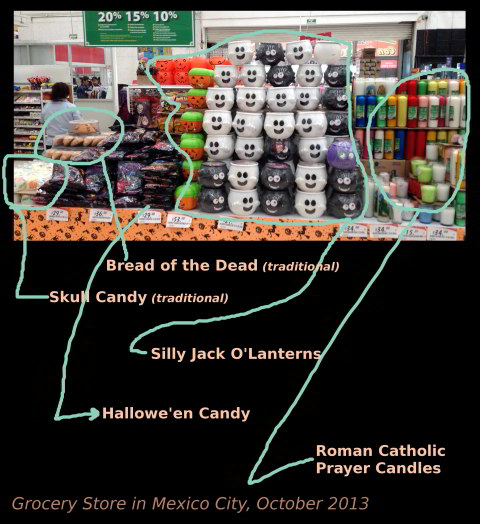Hallowe’en In Mexico (like never before)
I have never seen the marketing of Hallowe’en in Mexico like I’ve seen it this year. It has arrived with a vengeance, and it’s not going to be leaving anytime soon.
As usual, in Canada and the USA the discussion continues about how Christians should relate to this holiday. Some feel they should not be involved, or at least not fully. Others feel that they should be. And unfortunately, the discussion between the two groups isn’t always friendly. Why can’t we have a conviction and still have a discussion?
If we lived in the USA or Canada, we would have to make a decision based on our own convictions, our friends, the community, and so on. But we live in Mexico. And it ain’t the same here.
Many of you know that Mexico has a completely different holiday on the 1st and 2nd of November – the Days of the Dead.
I’ve written about the Days of the Dead before. But to summarize, it’s a highly valued part of Mexico culture. In a mix of ancient native beliefs about travel through the underworld and Roman Catholic beliefs, people use this time to honour and speak to dead relatives. It is believed that the dead return during this time, and so altars are built for them with items to help them on their journey.
Because of various conflicts with the biblical view of death and our relationship with the dead, Christians here generally break from this tradition. Which is very hard to do, and will likely result in major conflict or even persecution.
Hallowe’en, on the other hand, is a largely imported holiday from the USA. Even in the short time we’ve lived here, it’s gone from a fairly rare addition to the Days of the Dead to a full fledged partner. Take for example this sales table at a local supermarket:

So we have candy skulls – very traditional on the Days of the Dead (something kids will give to each other). Also very traditional is Bread of the Dead. And then we have candy, of course. Plastic Jack o’lanterns. And Roman Catholic prayer candles.
As Hallowe’en has returned with a vengeance this year, I’ve noticed that the cartoony characters (like skeletons) that are familiar to the rest of North America have become a part of the Days of the Dead. It’s being commercialized much like Hallowe’en in other countries.
And not only is November 1&2 influenced by Hallowe’en, Hallowe’en is influenced by November 1&2. Here in Mexico, the fun costumes are rare. The emphasis is on the dark, the dead, the occultic.
But of course, you don’t have one without the other. They are becoming mixed and mingled – the animistic beliefs, religious symbols, commercial marketing – all working together to make death bigger in Mexico than ever before.
And at this point, there’s no sign that the commercialization will bleed the religion from the celebration. In spite of the fun that’s always been there, it’s serious business in Mexico, and that means real beliefs and confusion.
A Mexican once shared with us his frustration that Mexico seems to import anything and everything into its culture without any kind of discernment. And so many Mexicans simply dislike Hallowe’en because it’s a “foreign” holiday.
Some Christians here seem to be importing an anti-Hallowe’en sentiment from the USA. But it’s not the same here. It’s a whole different story. Not a good story.
So please don’t look at Mexico and think that we’re having the same discussions as the rest of North America about the 31st of October. The issues are much, much different here.
As for our family, in an effort to honour a very important and living member of the family, we traditionally go out and have a birthday bash. 🙂 Oh, and of course I’m all for celebrating Reformation Day – a holiday just as old (or older) than modern Hallowe’en, celebrating a historic revival that God used to change the world – and bring life and light, not more death and darkness.
More detail about the Days of the Dead here: Festival of colour, mockery and family
